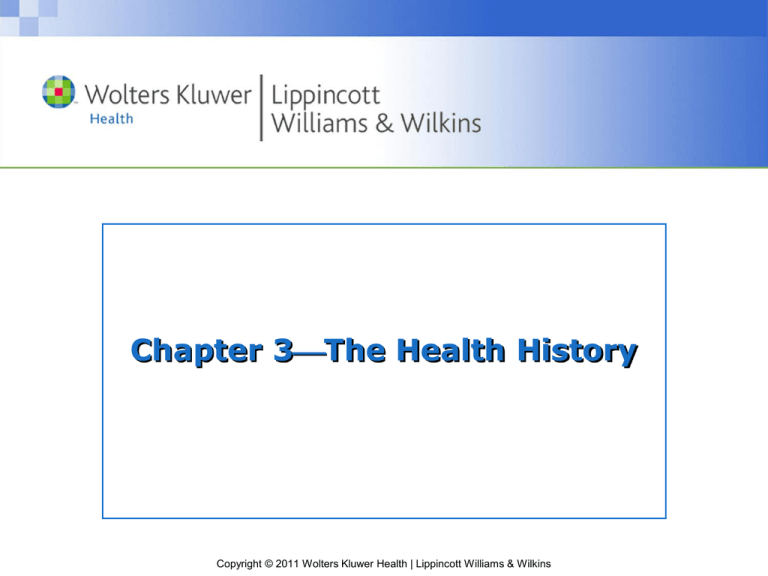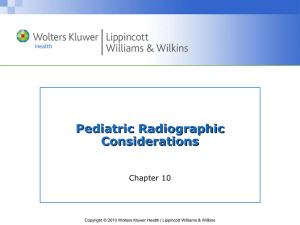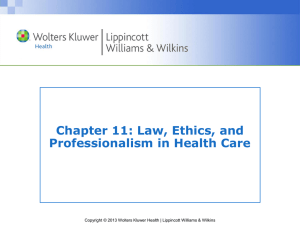The Health History - Tri-County Community College
advertisement

Chapter 3The Health History Copyright © 2011 Wolters Kluwer Health | Lippincott Williams & Wilkins Health History Introduction • Purpose of the health history – Subjective data • Uncomfortable questions • Therapeutic communication for collaboration • Nurse uses special techniques and communication skills Copyright © 2011 Wolters Kluwer Health | Lippincott Williams & Wilkins Primary and Secondary Data Sources • Patient is considered the primary data source • Charts and family members are considered secondary data sources • Subjective information • Secondary sources Copyright © 2011 Wolters Kluwer Health | Lippincott Williams & Wilkins Reliability of the Source • Reliable historian • Inaccurate historian • The nurse – Records the person who provides the information – Notes any discrepancies – Identifies other sources (such as previous records) to confirm the history Copyright © 2011 Wolters Kluwer Health | Lippincott Williams & Wilkins Components of the Health History • Demographical data • Reason for seeking care • History of present illness – Location – Duration – Intensity – Quality/description – Aggravating/alleviating factors – Pain goal – Functional goal Copyright © 2011 Wolters Kluwer Health | Lippincott Williams & Wilkins Components of the Health History (cont.) • Past health history – Current medications and indications – Family history • Genogram • Functional health assessment – Gordon’s framework • Growth and development Copyright © 2011 Wolters Kluwer Health | Lippincott Williams & Wilkins Components of the Health History (cont.) • Review of systems – General health state – Nutrition and hydration – Skin, hair, and nails – Head and neck • Eyes • Ears • Nose, mouth, and throat Copyright © 2011 Wolters Kluwer Health | Lippincott Williams & Wilkins Components of the Health History (cont.) • Review of systems (cont.) – Thorax and lungs – Heart and neck vessels – Peripheral vascular – Breasts – Abdominal-gastrointestinal – Abdominal-urinary Copyright © 2011 Wolters Kluwer Health | Lippincott Williams & Wilkins Components of the Health History (cont.) • Review of systems (cont.) – Musculoskeletal – Neurological – Male genitalia – Female genitalia – Anus, rectum, and prostate – Endocrine and hematologic systems Copyright © 2011 Wolters Kluwer Health | Lippincott Williams & Wilkins Teaching Opportunities • Gathering information on health-promotion practices • Identifying patient areas of concern and risk • Patient teaching throughout review of systems Copyright © 2011 Wolters Kluwer Health | Lippincott Williams & Wilkins Question Tell whether the following statement is true or false. The patient’s chart is considered a primary source of information for the health assessment. Copyright © 2011 Wolters Kluwer Health | Lippincott Williams & Wilkins Answer False Rationale: Charts and family members are considered secondary data sources. Copyright © 2011 Wolters Kluwer Health | Lippincott Williams & Wilkins Psychosocial and Lifestyle Factors • Social, cultural, and spiritual assessments • Mental health • Human violence • Sexual history and orientation Copyright © 2011 Wolters Kluwer Health | Lippincott Williams & Wilkins Lifespan Considerations • Pregnant women • Newborns, children, and adolescents • Older adults Copyright © 2011 Wolters Kluwer Health | Lippincott Williams & Wilkins Cultural and Environmental Considerations • Cultural factors influence the beliefs of patients about their health status • Illnesses that are more common among groups of patients • Patient’s environment might include safety in the home, transportation issues, or community involvement • Exposure history Copyright © 2011 Wolters Kluwer Health | Lippincott Williams & Wilkins Question • Why is it important to assess human violence? A. Because of the high prevalence of physical abuse in children and women B. Because all women are abused during pregnancy C. Because all women are abused at sometime in their life D. Because of the potential for abuse among pregnant women Copyright © 2011 Wolters Kluwer Health | Lippincott Williams & Wilkins Answer • A. Because of the high prevalence of physical abuse in children and women • Rationale: Because of the high prevalence of physical abuse in children and women, especially during pregnancy, many nurses routinely question patients about this (Centers for Disease Control and Prevention, 2008). Copyright © 2011 Wolters Kluwer Health | Lippincott Williams & Wilkins











